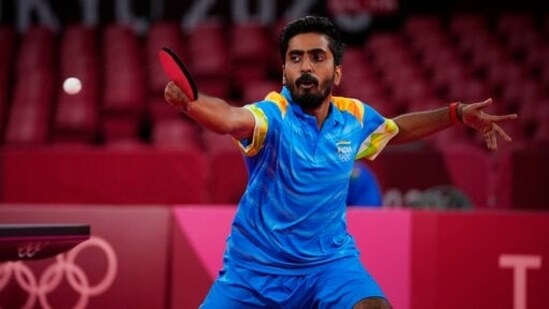‘Singles medal my main goal’: Sathiyan Gnanasekaran
In the four years since India’s paddlers glittered in Gold Coast with an eight-medal haul, Sathiyan Gnanasekaran has been part of a first-ever Asian Games Indian team medal, breached the top-25 singles world rankings and brushed aside a couple of top 10 players on the tour. At the 2018 CWG, Sathiyan had a neat spread of a gold (team), silver (doubles) and bronze (mixed). In singles at the multi-nation events, it’s yet to come together for the 29-year-old and translate into a medal.  PREMIUM
PREMIUM
And that is precisely what India’s highest-ranked singles paddler is out to do in Birmingham. Excerpts from the chat with the world No 35:
The 2018 CWG not only elevated Indian table tennis but also your status in it. How have you evolved as a player from then?
I’ve certainly become a more mature player. I’ve improved on the court intelligence, on-court movement, footwork, understanding of players’ strengths and weaknesses. The 2018 CWG was my first such event, and now I’ve (the experience of) three in CWG, Asian Games and Olympics. Mentally I’m better prepared now. The last four years have been a great learning experience for me. I’ve seen it all: big Games, Covid, travel. On the game front, I’ve started to play more aggressively and improved on the serve and receive. There have been some definite improvements that should come in handy at the CWG.
You've had a lot of firsts in the last few years, but perhaps the one thing missing is a singles medal at a multi-nation event…
One of my primary goals in this CWG is to win a singles medal as well. It’s going to be hard. Pitch (England’s Liam Pitchford, ranked 19) and Aruna (Nigeria’s Quadri Aruna, ranked 12) are there among the top 20 apart from a few other England players and, of course, Sharath (Kamal) and I. So it’s a packed field. And such Games are always different. But the way I’ve been playing, I think I have a great chance. No doubt, singles medal will be the toughest, but that is my main goal. And in team, doubles and mixed, we’re primed to win a medal as well. I really want to change the colour of my medal in men’s and mixed doubles from last time.
What has been your biggest learning from the second-round exit in singles from Tokyo Olympics?
I could see how important it is to keep changing strategies, have variations in your game (Sathiyan lost to the then 95th-ranked Lam Siu-hang 3-4 after being 3-1 up). Once you are in the lead and your opponent comes back with something, you really need to have Plan B, Plan C, two-three strong strategies. You need to work on your game on that front instead of just going blind. So I started to work on different areas of my game, like to have more variations in my armour. And to improve on my physical strengths—have more explosive power behind my strokes. Mentally, I have a much better understanding now of how it is to play in a Games-like event. And that’s something I have learned a lot from Tokyo.
You’ve tasted victories against top-10 players, world No 7 Darko Jorgic being the most recent in Zagreb last month. Is it now about doing that at a more consistent basis especially in the bigger events?
Beating a player like Darko, the best European at the moment, was a great win. It couldn’t have come at a better time just before the CWG. It has given me a great sign of confidence, and also positivity that I’m headed in the right direction in my aggressive game style. Playing aggressive is the only key to defeating top-10 players. I’ve always been a more consistent, rallying kind of player, but that’s only good up to a certain level. If you want to break into the top 10, you have to take your chances, train that way and play bold table tennis. It’s a work in progress, but I believe there will only be improvements going ahead.
You and Manika have been making a few deep runs in WTT tournaments as a mixed pair. How has it been playing and training with her after Tokyo?
I think the results have been speaking for themselves. The progress we’ve shown in the last 8-9 months is something that has even surprised us, to be frank. It’s phenomenal that in just 8-9 months, we’re aiming to beat the top 3-4 pairs in the world (the Indian duo is ranked 6th). We complement each other in our game styles, and also spend quality time training. We understand each other’s game, speed, tactics really well. Our primary goal is the Paris Olympics, and in the lead-up if we can pick up the gold in Birmingham, it will be amazing.
Is there belief in the squad that you can match the 2018 tally despite the challenging build-up involving selection issues and court cases?
It’s not going be easy, especially with the competition. England and Nigeria are much stronger teams this time around. Eight medals was a dream for table tennis. If we can replicate that, I would say this would be even better than Gold Coast. Because having that kind of background and then coming back to win eight, it will be something. But even if we win 5-6 medals, I would still call it a fantastic CWG. If we go beyond that, all the more amazing.
Experience unrestricted digital access with HT Premium
Explore amazing offers on HT + Economist Start 14 Days Free Trial Already Subscribed? Sign In
Disclaimer: The copyright of this article belongs to the original author. Reposting this article is solely for the purpose of information dissemination and does not constitute any investment advice. If there is any infringement, please contact us immediately. We will make corrections or deletions as necessary. Thank you.







